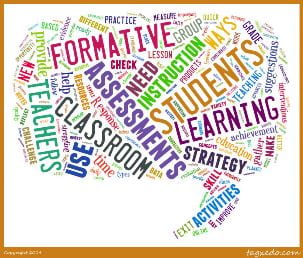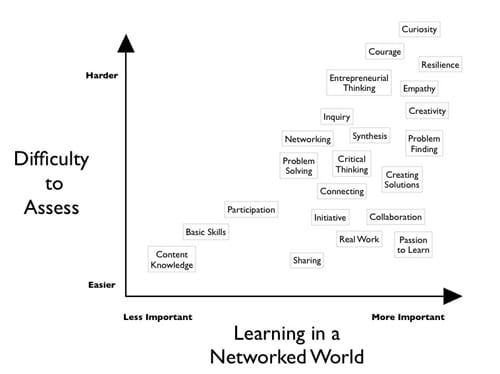Providing learners with opportunities to share ideas and reflect on how they are learning are key aspects of formative assessment. By encouraging metacognition, dialogue and self-assessment, formative assessment practices can encourage deeper learning among individuals and groups. Digital technologies can be used to enhance this process as learners make their thinking visible to themselves and others. Smart intelligent tutors and AI teaching assistants are on the horizon…and formative assessment is one potential use. Online polling is another aspect of formative assessment, but there are others, such as concept maps or data visualizations.
Will Richardson posted this graph on his blog:
He said:
… our school assessment lives primarily in the bottom left part of that graph … we rarely if ever get to the “immeasurable” stuff that resides toward the top right. To put it another way, we focus in schools on that which is quantifiable when, I think, our real value as places of learning rests in that messy stuff that isn’t.
Formative assessment can begin to get at this messy stuff.
“When the cook tastes the soup, that’s formative; when the guests taste the soup, that’s summative.” (Robert Stakes)
Janet Fulk, a professor with Bakersfield College, noted that good assessment required faculty with expertise and resources:
- to measure and report learning
- in a variety of courses
- under diverse conditions
- about students with varied abilities
- and disparate levels of academic engagement.
Angelo and Cross in Classroom Assessment Techniques (1993) noted that formative assessment focuses on improving the quality of learning as opposed to gathering evidence for evaluating and grading students. They suggested that faculty need to:
- Make goals and objectives explicit
- Gather feedback from students on the extent to which these goals and objectives were being met
- Provide feedback early and often to students, and
- Help students learn to self-assess their progress
Black and Williams (1998) referred to formative assessment as assessment for learning, as opposed to assessment of learning. They stated that the key elements of formative assessment include:
- The identification by faculty and learners of learning goals, intentions or outcomes and criteria for achieving these.
- Rich conversations between faculty and students that continually build and go deeper.
- The provision of effective, timely feedback to enable students to advance their learning.
- The active involvement of students in their own learning.
- Faculty responding to identified learning needs and strengths by modifying their teaching approach(es).
Carol Evans suggested some pragmatic actions for effective feedback and feed-forward:
- ensuring an appropriate range and choice of assessment opportunities throughout a program of study;
- ensuring guidance about assessment is integrated into all teaching sessions;
- ensuring all resources are available to students via virtual learning environments and other sources from the start of a program to enable students to take responsibility for organizing their own learning;
- clarifying with students how all elements of assessment fit together and why they are relevant and valuable;
- providing explicit guidance to students on the requirements of assessment;
- clarifying with students the different forms and sources of feedback available including e-learning opportunities;
- ensuring early opportunities for students to undertake assessment and obtain feedback;
- clarifying the role of the student in the feedback process as an active participant and not as purely receiver of feedback and with sufficient knowledge to engage in feedback;
- providing opportunities for students to work with assessment criteria and to work with examples of good work;
- giving clear and focused feedback on how students can improve their work including signposting the most important areas to address;
- ensuring support is in place to help students develop self-assessment skills including training in peer feedback possibilities including peer support groups;
- ensuring training opportunities for staff to enhance shared understanding of assessment requirements.
Carol Evans (2013). “Making Sense of Assessment Feedback in Higher Education”. Review of Educational Research, March 2013, Vol. 83, No. 1, pp. 70–120
Jack Buckley, chief scientist at Imbellus, noted that machine learning and AI offer promise in updating formative assessment, by providing each student with personalized learning that adjusts as students and AI provide each other feedback. Assessments can shift based on the level of understanding a student demonstrates. As Jack noted, “…Coupled with a robust system of formative assessment, ML/AI-enhanced personalized learning may be able to tell teachers what the optimal next lesson is on a student-by-student level, saving time and increasing student learning.”
As the readings suggest, digital technology can be used in formative ways to help students assess their learning. We will look at two – concept maps and digital polling. There are many more … Edutopia listed 56.
For more on formative assessment, check out:
- Fiock and Garcia (2019) How to give your students better feedback with technology.
- Dyer (2013) Digital Technology Tools for Implementing Formative Assessment – Post One
- Dyer (2013) Digital Technology Tools for Implementing Formative Assessment – Post Two
- Ferrara (2019) Testing AI: The Evolution of Educational Assessment

